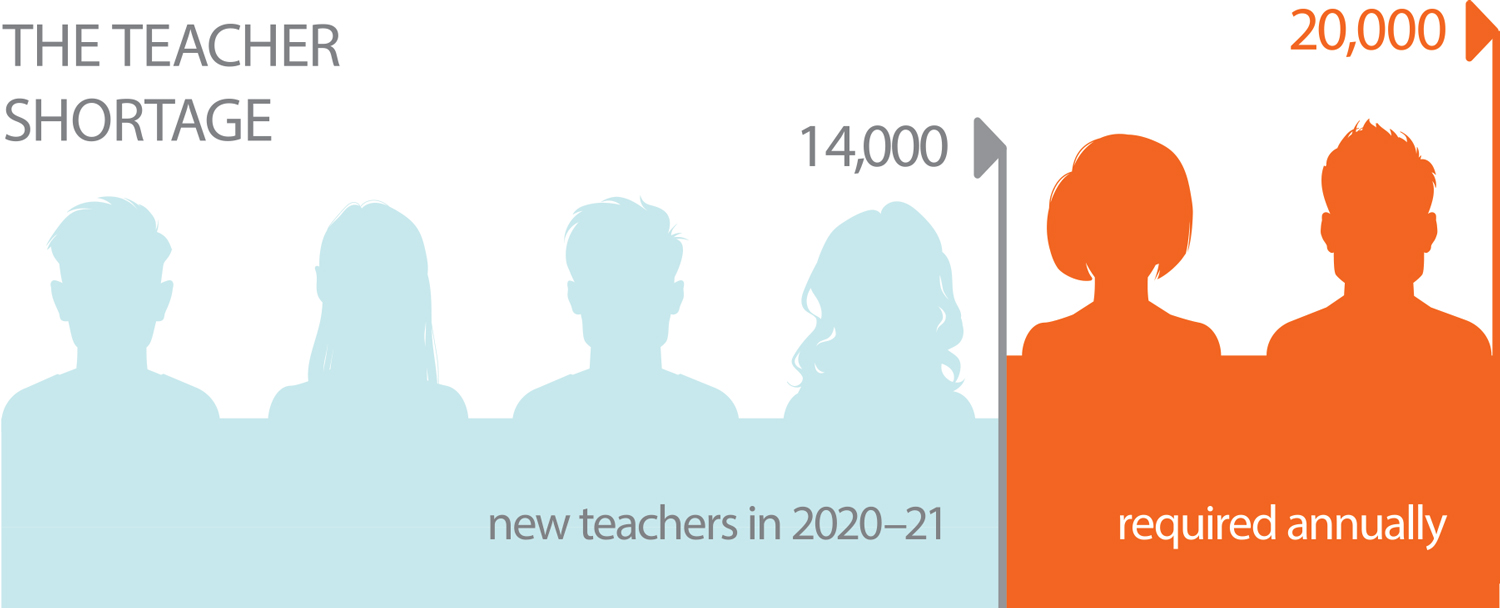
t wasn’t a planned photo-op when San Lorenzo Unified School District Superintendent Daryl Camp was photographed in September substituting for a high school science class, but a necessity. Camp and other administrators, as well as any available teacher, have become desperately needed substitutes at a time when schools are facing a dire shortage of teachers, substitutes and support staff.
The teacher shortage in this Alameda County-based district is primarily concentrated at the secondary sites where teachers must hold a single subject credential, and has significantly impacted math and science classes, Camp said. As of the beginning of October, there were more than 15 vacancies across four high schools and three middle schools — one high school had five math and science vacancies.
Districts have additional state and federal funding to use for learning acceleration and other programming to boost student achievement but are fighting for the same limited number of teachers and support staff to make it all happen. Districts including Berkeley USD, Pacific Grove USD, Elk Grove USD, Lodi USD, Salinas Union High School District and more have increased substitute teacher pay to entice available workers. Monterey Peninsula USD has increased its retiree daily rate for teachers, while Long Beach USD is offering signing bonuses for school psychologists and speech therapists, and Pajaro Valley USD is offering signing bonuses for bus drivers. Dry Creek Joint Elementary School District, one of the fastest growing districts in the state, boosted job post listings on Facebook and hosted an in-person job fair during which prospective employees could be interviewed and potentially hired on the spot pending a background check. Chromebooks were also made available to allow people to take substitute screening tests onsite.
There aren’t nearly enough substitutes to cover vacancies or fill in for absences, which have increased as teachers are required to quarantine should they show symptoms or test positive for COVID-19. And in many districts where the demand for independent study is now higher than expected , the pool of teachers is stretched even thinner as educators move to teach virtually rather than in person.
This isn’t sustainable.

With an ever-shrinking pool of fully credentialed teachers, districts are often left having to make compromises to ensure classrooms are staffed. This could mean cutting the number or types of courses offered, increasing class sizes or filling vacancies with substitute teachers, or those on intern permit or waiver credentials, said Learning Policy Institute (LPI) researcher and policy analyst Desiree Carver-Thomas.
“All of those scenarios have serious implications for student achievement,” Carver-Thomas said, noting the problem has been exacerbated by the pandemic, with many districts creating new positions in order to meet the needs of their students as they come back to school. “Districts started the year still having vacancies to fill and when there are vacancies towards the beginning of the school year, it becomes more and more likely that those will be filled with teachers on those interim permit and waiver credentials.”
San Lorenzo USD is one such district forced to utilize candidates on short-term and provisional credential permits in order to at least ensure students have a regular presence in the classroom, rather than relying on a series of short-term substitutes. “While we would love to have fully credentialed teachers in front of all of our students, our next best option is to try to get someone that’s working toward a more permanent credential,” Camp explained. “In other words, we’re looking for stability for our students.”
In previous years, between 50–175 secondary students enrolled in San Lorenzo USD’s independent study program. This year, the district is serving about 200 secondary and 200 elementary students in its program, which has become virtual.
“The need to expand our independent study program resulted in having to collapse various elementary school classes and reassign teachers to our independent studies program,” Camp said. “Since the Legislature provided regulations for independent study in July, many school districts did not have adequate planning time to plan for the significant increase in families who applied for an independent study program. Of course, like many of us, the Legislature may not have anticipated that there were likely more families interested in an independent study program due to the surge of the delta variant during the summer.”
While the California Department of Education reported in October that just under 4 percent of students were enrolled in independent study at that time, some, like San Bernardino City USD saw student participation jump to 11.7 percent. But that isn’t the district’s main challenge. Like Camp in San Lorenzo, officials cited the overall competition for limited resources as the main hurdle, with tried-and-true recruitment methods remaining critical. “We all knew the [teacher] shortage was here, and of course COVID has added to it,” said district Board President Gwendolyn Dowdy-Rodgers. “I think what we’ve been grateful to have is our substitute teachers — we call them our guest teachers — who are taking an interest to try to come on and help us with the problem.”
“Our guest teacher workforce right now has become a go-to for us in terms of recruiting and hiring, as we continue to train them up,” agreed Marcus Funchess, San Bernardino City USD assistant superintendent of Human Resources. “And last year we took over 400 in our district and allowed them to be in our classrooms virtually with master teachers. So, our veteran teachers, our master teachers and our demonstration teachers are supporting our efforts, and that’s what’s keeping us moving forward in a very innovative way.”
When the state launched a Teacher Shortage grant competition, the district along with the Riverside County Office of Education submitted an application to partner with California State University, Riverside, to provide tuition support for classified district personnel such as paraprofessionals, secretaries and custodians to become teachers. The district also applied for a grant in partnership with UC Riverside to provide tuition support for substitute teachers looking to pursue a special education certificate. San Bernardino City also supports tuition reimbursement for alumni working as substitute teachers as they pursue a teaching degree.
Some of the teacher pipelines San Bernardino has established are Grow Your Own programs, which emphasize recruiting, developing and retaining educators already in the community — often drawing from people who are connected to the school but may not have considered teaching or who need additional support to enter the profession. “Grow Your Own strategies are a way of creating that on-ramp to becoming a teacher and facilitating that on-ramp for folks who are already interested and working in education,” said Thomas Gold, senior associate partner at Bellwether Education Partners.
- Maintaining and expanding high-retention pathways into teaching, such as teacher residencies and Grow Your Own pathways.
- Providing service scholarships to all teacher candidates who complete preparation and commit to teach in high-need fields and locations.
- Ensuring equitable access to mentoring and induction programs for novice teachers.
- Strengthening systems to recruit and prepare aspiring teachers earlier in the educational process, including through community college and high school pathways.
The state also plays a significant role in incentivizing individuals to go into teaching, LPI’s Carver-Thomas said. This may mean considering multiple pathways for candidates to demonstrate competence or institutionalizing existing investments in high-retention pathways, such as California’s Teacher Residency Program and Classified School Employees Credentialing Program, that have been shown to produce well-prepared teachers who stay in the profession at higher retention rates.
Included in the 2021–22 state budget was $2.8 billion for programs to attract, retain and train educators — $1.5 billion for a new Educator Effectiveness Block Grant over five years for staff professional development and $1.3 billion for other programs. These include expanding teacher residencies, awarding Golden State Teacher grants for teacher credential candidates who commit to teaching at a low-income school for four years, and funding for classified employees to become credentialed teachers. Combined, the programs could supply 50,000 new teachers over the next five years.
“Teacher residencies are incredible programs that can help to address the pipeline issues at the speed that is really necessary,” Carver-Thomas said. “Residents are able to take a full year of clinical practice, teaching under the wing of a master teacher while they’re getting a master’s degree, often at a partnering university, and committing to teach at the district where they’re doing the residency for another several years. These programs tend to be more racially and ethnically diverse, have high retention rates after the residency is over and [participants] tend to be rated effective teachers.”
San Lorenzo USD has filled more than a dozen special education, math and science vacancies in the last few years with teachers from the Philippines through a J-1 visa program. And the district’s teacher residency program partnership with the Alder Graduate School of Education has helped recruit from the community a “significant number of teachers of color and some teachers that are multilingual,” Camp said. “I think if the recruits are already in the community, they reflect the community.” About 93 percent of students in the district are students of color, he said.
San Bernardino City officials have seen the same trend. The district serves a student population of whom 78 percent are Hispanic, 11 percent are Black, 5 percent are white, 1 percent are Asian and 5 percent are other races. By its third year, the Teacher Shortage grant was supporting 21 classified employees, more than 60 percent of whom are either Black, Hispanic, Asian or Pacific Islander, officials said.
In 2019, the district launched the Teachers of Color campaign and established a committee that meets monthly to discuss how to attract more teachers of color to the district and retain them. The campaign is in the early stages of identifying students of color in its high schools and in local colleges to get them interested and enrolled in credential programs, support them in matriculating through college, and bringing them into the field of education through mentorship and other strategies, Funchess said.
“As we look at it from two angles — the teacher shortage and then diversifying our workforce — we have to grow our own educators because it helps us capture the type of educator that we want to bring into the district,” he continued. “An educator that is committed to San Bernardino has a purpose for serving here and understands the importance of being service-minded.”
San Bernardino City USD’s HR department is working to make sure new educators are provided the necessary support to boost retention. This includes training in social-emotional learning and cultural competency, and coaching for all new teachers, whether they’re probationary, interns, or even emergency teachers, Funchess said.
A major focus moving forward will “be on retaining our teachers by understanding their needs,” Funchess said. “We have identified the right teachers for our district. Now, how can we make sure that we’re doing everything necessary to retain them? Once your retention rates are where they need to be, then you don’t have to grapple so much with the shortages.”
Alisha Kirby is a staff writer for California Schools.